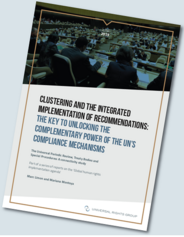This policy report calls for a fundamental rethink of the international compliance system: instead of the three main implementation mechanisms being perceived (and, in the case of Treaty Bodies and Special Procedures, perceiving of themselves) as separate, distinct, unconnected and – even – as operating in tension; they should be seen as three complementary parts of a single human rights compliance engine.
In order to strengthen State compliance with international human rights obligations and commitments, the UN has created three broad types of human rights mechanism, each designed to work with States to review levels of implementation and provide recommendations for improvement. These mechanisms are: the Special Procedures, the Treaty Bodies, and the Universal Periodic Review (UPR).
Each mechanism arose and evolved separately, responding to a particular context and time; consequently, each has its own characteristics and methods of work (albeit sharing important similarities), and has its own particular strengths and weaknesses.
Due to this parallel - and seemingly uncoordinated - development, the three mechanisms have traditionally been seen as separate and unconnected. However, this policy report argues that such a view is outdated and serves to create barriers to improved implementation and impact.
The three mechanisms actually have the same fundamental purpose and each executes its mandate in broadly the same way. Each works through engagement and cooperation with States; each seeks information from national civil society; each seeks to review and assess levels of State compliance with international human rights obligations and commitments; and each produces recommendations to States on how to improve performance and compliance in the future. Crucially, the three mechanisms - while distinct - are complementary rather than competitive, and work best in concert. The mechanisms are, in short, three parts of a single international human rights compliance engine.
These similarities and complementarities have allowed the three mechanisms to contribute to the generation, for each UN member State, of a rich, comprehensive and politically nuanced framework of human rights recommendations and guidance: a ‘blueprint’ for domestic human rights implementation, reform and progress.
Source: Universal Rights Group, Switzerland

